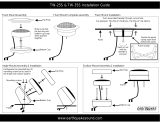
Operator’s manual
3
1 Foreword ....................................................................................................................5
2 Introduction ...............................................................................................................6
2.1 Means of representation for this operator's manual....................................................... 6
2.2 Wacker Neuson representative...................................................................................... 7
2.3 Described machine types............................................................................................... 7
2.4 Identification of the machine .......................................................................................... 8
3 Safety .........................................................................................................................9
3.1 Principle ......................................................................................................................... 9
3.2 Qualification of the operating personnel....................................................................... 12
3.3 Protective gear............................................................................................................. 13
3.4 Transport...................................................................................................................... 14
3.5 Operating safety........................................................................................................... 15
3.6 Safety during the operation of combustion engines..................................................... 17
3.7 Maintenance................................................................................................................. 19
4 Safety and information labels ................................................................................21
5 Scope of delivery ....................................................................................................23
6 Components and operator's controls ...................................................................24
6.1 Drive components and operator's controls................................................................... 24
6.2 Flexible shaft components ........................................................................................... 26
6.3 Vibrator head components........................................................................................... 26
7 Structure and function ...........................................................................................27
7.1 Application.................................................................................................................... 27
7.2 Functionality................................................................................................................. 27
8 Transport .................................................................................................................28
8.1 Lifting eyes and tie-down lugs...................................................................................... 28
8.2 Transporting the machine ............................................................................................ 29
9 Initial start up ..........................................................................................................30
9.1 Mounting the vibrator head .......................................................................................... 30
10 Use and operation ...................................................................................................32
10.1 Prior to starting the machine........................................................................................ 32
10.1.1 Checks before startup..................................................................................... 32
10.2 Starting up.................................................................................................................... 33
10.2.1 Starting the engine.......................................................................................... 33
10.3 Operating the machine................................................................................................. 35
10.4 Decommissioning......................................................................................................... 37






















